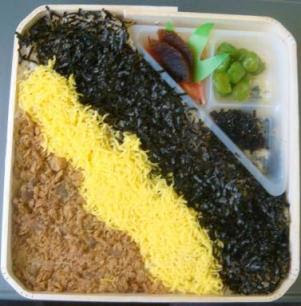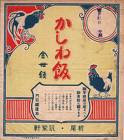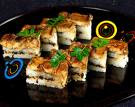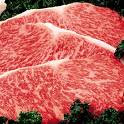[ . BACK to WORLDKIGO TOP . ]
::::::::::::::::::::::::::::::::::::::::::::::::::::::::::::::::::::::::::::::::::::::::::::::::::::
Niigata prefecture

Niigata Prefecture (新潟県, Niigata-ken) is a prefecture of Japan located on Honshū island on the coast of the Sea of Japan. The capital is the city of Niigata. The name Niigata literally means "New Lagoon".
Niigata prefecture was originally divided into
Echigo Province and
Sado Province until the Meiji Restoration. During the Sengoku period it was ruled by Uesugi Kenshin.
The major industry in Niigata is agriculture. Rice is the principal product, with Niigata ranking 2nd (after Hokkaidō) among the prefectures for total rice output. The area around Uonuma is especially known for its Koshihikari variety of rice, which is widely thought of as the highest quality rice in Japan.
Rice-related industries are also very important to the local economy. Niigata prefecture is known throughout Japan for its quality sake, senbei, mochi, and arare. In sake production, Niigata is third in the country after Gunma and Kyoto prefectures.
The prefecture is famous as the original home of the ornamental carp known as koi, and the best-quality koi are still considered to come from the farms of Niigata.
Niigata is known for the following regional specialities:
Uonuma koshihikari rice: considered the best quality rice in Japan.
Shoyu (soy-sauce) and Yofu (western-style) katsudon.
Shoyu sekihan.
Sasa-dango, sasadango (mochi balls filled with red bean paste, seasoned with mugwort and wrapped in bamboo leaves).
Po-po-yaki (steamed bread flavored with brown sugar).
"Tsubame-Sanjo ramen" (ramen made using thick udon-style noodles).
Kirazu (dishes using okara).
Kakinomoto (edible chrysanthemums).
Kanzuri (a special seasoning from Myōkō (Myookoo, Myoko) made by leaving chili pepper exposed on snow, then adding flour, salt and yuzu).
© More in the WIKIPEDIA !
 Tenchijin (天地人)
Tenchijin (天地人)
is the 48th NHK Taiga drama for 2009! NHK大河ドラマ
The life of Naoe Kanetsugu
直江兼続(なおえ かねつぐ 1560 - 1619)
Kanetsugu in Yamagata
:::::::::::::::::::::::::::::::::::::::::::::::::::::::::::::::::::::::::::::::::::::::::::::::::::
Niigata Dishes 新潟郷土料理
abura-age 油あげ deepfried tofu pouches
Tochio aburage あぶらげ (aburaage is called "aburage" in Tochio 栃尾), where there is even an "aburage matsuri" festival あぶらげまつり.
They are made with 100 % Niigaga soybeans. With leek and ginger, they are a delicacy.
. . . CLICK here for Photos !
anbo あんぼ balls from rice and vegetables
rice flour and finely chopped vegetables of the season, sansai and soy beans are kneaded with them. A food for the cold winter morning breakfast.
. . . CLICK here for Photos !
Ambo
ayu no ishiyaki 鮎の石焼 ayu fish fried on hot stones
You collect stones by the riverside and heat them up for 2 hours. Thes the innards of the fish and miso paste are fried on the stone. It is just a little bitter in taste.
boodara no nitsuke ぼうだらの煮付け simmered dried cod
boodara 棒鱈 "stick tara" is tara cut in three pieces and dried.
It is simmered with sugar and soy sauce for half a day to get the bones soft.
boodara is a kigo for spring.
. . . CLICK here for Photos !
Stockfisch
tara たら【鱈】codfish, haddock
botamochi ぼたもち rice cakes covered with sween bean paste
... see
mochi
dengaku 田楽 food on skewers, with misopaste
Dengaku dance and food with amazing details
Usually firm tofu and eggplants on skewers, grilled with miso paste. Also satoimo potatoes, fish and other vegetables are grilled like this.
donbikoni, donbiko-ni, どんびこ煮 donbiko-ni cooked heart of salmon
speciality of Murakami area.
Cooked in sweet sauce. Precious food since there is only one heart in each fish caught.
. . . CLICK here for Photos !
egoneri (igoneri) えごねり(イゴネリ)seaweed
The seaweed "egogusa エゴ草" from the wild sea of the Nihonkai is full of minerals.
. . . CLICK here for Photos !
. The Azumi clan 安曇族 and ego /igo dishes .
Fucha ryori, fucha ryoori 普茶料理 Chinese monk quisine
gajini がじに cooked innards of salmon
from Murakami area. Cooked in a hodgepodge with vegetables and spicy sauce.
gibasani, gibasa-ni ぎばさ煮 boiled gibasa seaweed
also called akamoku あかもく or nagamo ナガモ "long seaweed"
It grows in shallow sea water and grows to seven meters long.
. . . CLICK here for Photos !
:::::::::::::::::::::::::::::::::::::::::::::::::::::::::::::::::::::::::::::::::::::::::::::::::::

hegisoba, hegi soba へぎそば buckwheat noodles
from Ochiya town 小千谷そば
Buckwheat flour is mixed with the seaweed
funori 布海苔(ふのり), hitting the dough in a special way. (nori 糊 glue). The noodles are quite firm.
hegi 片木 is a thin wooden board
hegi ita 剥板, that was used like a shingle for a roof.
They are served in small portions arranged like shingles, "swinging the hand once" 一手振り.
They are almost like zarusoba.
hime takenoko 姫たけのこ / 姫竹の子 small thin bamboo shoots
They are put in miso soup or boiled as a sidedish.
. . . CLICK here for Photos !
ibushi daikon いぶし大根 smoked radish
small radishes are smoked for about one week. Then it is cut and pickled in rice bran miso
(iburi gakko is from Akita)
:::::::::::::::::::::::::::::::::::::::::::::::::::::::::::::::::::::::::::::::::::::::::::::::::::
kachidokimeshi (かちどき飯)"rice to win the battle"
This was given to the warriours before sending them to battle, to encourage them, by their lord, Uesugi Kenshin 謙信公.
It includes kezurimono in auspicious five colors けずりもの, sengoku war sashimi 戦国さしみ, aburiyaki grilled meat 炙り焼き, nuka misoni boiled in miso 糠味噌煮, kurumi hitashi walnuts 胡桃浸し, kuromai black rice (brown rice) 黒米(玄米), atsumejiru soup 集め汁 koo no mono pickles 香の物, mizugashi mixed fruit 水菓子.
. . . CLICK here for Photos !
kaguramiso, kagura nanban miso 神楽南蛮味噌

kagurananban (kagura namban) is a kind of bell pepper. It has its name because it is full of bulbs like the mask for a kagura dance. In the village 新潟県中頚城郡中郷村 it is called buta koshoo, ぶたこしょう pepper for pigs.
. . . CLICK here for Photos !
kanzuri かんずり chili paste
fermented chili paste with yuzu citron and salt, kept in the snow and matured for 3 years. Sauce for nabemono
from the high areas of Echigo
. . . CLICK here for Photos !
kensayaki, kensa-yaki けんさ焼き "rice grilled on a sword tip"
When Uesugi Kenshin fought his many wars around 1550, he had his soldiers put onigiri on the top of the sword and grill them slightly before eating. It was his way to show resprct to the rice-growing farmers of his province.
Now it is eaten for the New Year and harvest festivals.
A bit of miso paste can be put on the grilled rice.
. . . CLICK here for Photos !
kiku no hana no sunomono 菊の花の酢の物
vinegared chrysanthemum flowers
Speciality of Niigata and other areas of Tohoku in Northern Japan. Eaten in autumn.
kinpira キンピラ simmered root vegetables
Kinpira (Japanese: 金平) is a Japanese cooking style that can be summarised as a technique of "sauté and simmer". It is commonly used to cook root vegetables such as carrot, burdock and lotus root, seaweeds such as arame and hijiki and other foods including tofu and namafu (生麸) (wheat gluten).
The dish features the use of soy sauce and mirin, as well as often slivered chili peppers.
© More in the WIKIPEDIA !
In Niigata, kinpira is put into rice flour dumplings,
kinpira dango キンピラ団子, (considered a sweet or oyatsu for the three o'clock snack)
. . . CLICK here for Photos !
kinpira soba キンピラ蕎麦 where the kinpira is put into the dipping sauce and then eaten with the buckwheat noodles.
kiriai きりあい daikon pickled in miso
daikon radish boiled, cut very small and mixed with miso. Some yuzu citron, black sesame and sugar is added. It can be put on rice just like this.
shiso-iri kiriai しそ入りきりあい with perilla leaves
from
Iwaya Onsen 岩室温泉
Iwa is a postal town at the "Northern Route" hokkoku kaidoo 北国街道.
another speciality of Iwaya is
suika misozuke すいか味噌漬 watermelon pickled in miso
Iwaya onsen manjuu 岩室温泉饅頭
Iwaya senbei 岩室せんべい
. . . CLICK here for Photos of the hot spring!
 koshihikari
koshihikari コシヒカリthe most famous brand of rice
Rice, kome, types of rice
koshihikari matsuril コシヒカリまつり
rice festival
. . . CLICK here for Photos !
:::::::::::::::::::::::::::::::::::::::::::::::::::::::::::::::::::::::::::::::::::::::::::::::::::::
Kubiki no oshizushi くびきの押し寿司 station lunch
from Naoetsu Station 直江津駅 and JR越後湯沢駅
ekiben from Kubiki area 頸城地方(くびきちほう)
Three different flavors in three layers. With local
koshihikari rice.
CLICK here for PHOTOS !
miruku yookan ミルクようかん milk desert
made from milk, sugar and kanten jelly. It comes in a container like yoghurt. Taken out it looks like a white piece of tofu. Cut into pieces, eaten with fruit.
mojio 藻塩 salt with seaweed
from Sado Island 佐渡
Salt of Japan
nasu no abura itame なすの油炒め fried eggplant
There are many different types of eggplants in Niigata. round eggplants 丸なす, long eggplants 長なす, eggplants "like brushes" 鉛筆なす、and 十全なす、水なす、漬けなす、巾着なす ...
Most of them are also prepared for tsukemono pickles.
nina 煮菜 "simmered leaves"
from leafy vegetables like Nozawana 野沢菜 and taina タイ菜
Simmered with beans and
abura-age tofu pouches.
.....
ni namasu 煮なます simmered daikon
grated daikon radish with crushed beand simmered with sugar and vinegar.
nodoguro のどぐろ / のど黒 "black neck" fish
expensive fatty white fish
CLICK here for PHOTOS !
noppejiru のっぺ汁 Vegetable broth with mixed ingredients
noppe stew, Noppe-Eintopf
:::::::::::::::::::::::::::::::::::::::::::::::::::::::::::::::::::::::::::::::::::::::::::::::::::::
okoshigata おこし型 colored sweet dumplings
Sado beanpaste cakes
filled with
anko sweet bean paste. They are very colorful, pink, green and yellow. They come in various auspicious forms, flowers or animals, made to stand up on decoration shelves, for example the Doll festival, the Boy's festival or O-Bon for the ancestors.
Sado Island
. . . CLICK here for Photos 佐渡のおこし型 !
okowadango おこわだんご balls
with okowa rice outside and sween anko inside
from Washima village 和島村
sankaku chimaki 三角ちまき rice wrapped in triangular form
prepared by lokal farmewifes for the husband to take to the field work.
Now it is mostly eaten as a sweet snack with kinako soybean flower.
. . . CLICK here for Photos !
:::::::::::::::::::::::::::::::::::::::::::::::::::::::::::::::::::::::::::::::::::::::::::::::::::::
sasadango 笹団子 (ささだんご) dumplings
sasazushi 笹寿司 Sushi served on sasa leaves
Sasa japonica. During the battles at Kawanakajima, there were no vessels to serve the food in. So the soldiers took these leaves, which are abundant, and placed their food on them.
. . . CLICK here for Photos !
Kawanakajima no tatakai 川中島の戦い
were fought in the Sengoku Period of Japan between Takeda Shingen of Kai Province and Uesugi Kenshin of Echigo Province in the plain of Kawanakajima, in the north of Shinano Province. The location is in the southern part of the present-day city of Nagano.
© More in the WIKIPEDIA !
:::::::::::::::::::::::::::::::::::::::::::::::::::::::::::::::::::::::::::::::::::::::::::::::::::::
Shagiri manjuu しゃぎり 饅頭 Murakami village
shake no sakebitashi 鮭の酒びたし salmon in rice wine
from the Murakami area 村上地方
Salmon pieces dried hard in the cold wind of the Sea of Japan were defrozen by putting them in a bit of hot rice wine and mirin.
salmon pickled in Japanese wine, marinated in Sake
. . . CLICK here for Photos !
shinsetsujiru miyuki jiru 深雪汁 "deep snow soup"
soup made of rabbit meat ウサギ肉. With pieces of radish, carrots, satoimo potatoes, shimeji mushrooms, konnyaku and burdock, it is full of nurishment on a cold winter day.
suketo no okijiru スケトウの沖汁 / スケトの沖汁
halibutt soup on the boat
prepared by fishermen on the boat. On the fishing trip to Sado island they caught sukettodara すけとうだら(介党鱈) and cut it into bite-size in a pot with miso soup or salt water.
Alaska pollack, Theragra chalcogramma
. . . CLICK here for Photos !
:::::::::::::::::::::::::::::::::::::::::::::::::::::::::::::::::::::::::::::::::::::::::::::::::::::
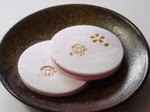 Takahashi ame
Takahashi ame 高橋あめ made with millet
from Echigo, the store Takahashiya makes them in the 14th generation
桜花くびきの里 hana saku biki no sato
“粟の古代飴”awa no kodai ame, millet sweets in the old style
They were the appointed sweet makers of the Lord. 御用菓子師
高橋孫左衛門商店 Takahashi Magozaemon Ameya 高橋あめや
上越市南本町3-7-2
:::::::::::::::::::::::::::::::::::::::::::::::::::::::::::::::::::::::::::::::::::::::::::::::::::::
tori no karaage (kara-age) 鳥のから揚げ
deep fried chicken
They serve a half chicken with one wing and one leg, all covered in curry powder and then deep fried for about 10 minutes. It is quite a volumous portion.
CLICK here for PHOTOS !
:::::::::::::::::::::::::::::::::::::::::::::::::::::::::::::::::::::::::::::::::::::::::::::::::::::
 tsuttoko つっとこ New Year Food
tsuttoko つっとこ New Year Food
packed in straw and hung in the cool space between the kitchen and outside.
About 14 different ingredients from the local fields are packed in a straw bag for each member of the family. A mikan was a special treat, so was a boiled egg. Home-made konnyaku was also put in the package.
Toge Shuraku, Matsudai Area 峠集落(松代エリア)(Tooge Shuuraku)
They also use wild rabbit for the
zoni New Year soup in Toge.
yama-usagi ozooni 山ウサギお雑煮
:::::::::::::::::::::::::::::::::::::::::::::::::::::::::::::::::::::::::::::::::::::::::::::::::::::
umazurahagi, umazura hagi ウマズラハギ "hagi with the face of a horse"
Thamnaconus modestus
Local people call it UMAZURA, horse face.
fish with a hard skin, which can be easily wrappef off. Eaten as Sashimi, with the liver in soysauce to dip.
CLICK here for PHOTOS !
Uonuma mochi 魚沼餅 mochi with rice from Uonuma town
Koganemochi 小金餅
This is the best rice in Japan to prepare
mochi.
. . . CLICK here for Photos !
wappa-han, wappameshi ワッパ飯
cooked rice and seafood are steamed in a bamboo basket
wappa-ni, wappani わっぱ煮 boiled in a wappa basket by placing hot stones into the broth of fish and vegetables
. . . CLICK here for Photos !
yukiguni maitake 雪国まいたけ
Sheep’s Head, Hen of the Woods
Grifola frondosa
. . . CLICK here for Photos !
This is a special brand from Niigata. It even has a corporation in America to sell these mushrooms.
Maitake mushrooms KIGO
vinegar from yukiguni maitake 雪国まいたけ絞り黒酢
maitake tempura まいたけ天ぷら
Reference : fresh Kosher maitake mushrooms
zenmai abura itame ぜんまい油炒め fern fried with oil
Osmunda japonica, Taubenfarn
. . . CLICK here for Photos !
see: sansai, mountain vegetables
zooni 雑煮 New Year Soup
prepared with salmon and chicken meat and plenty of local vegetables.
Mochi are also put into the soup. They say it is the best zooni of all Japan!
zuiki no sunomono ずいきの酢の物 cooked stem from yam
from the yam potato yatsugashira 八つ頭
Zuiki from Wakayama
芋茎(ずいき) Zuiki Taro and the 随喜 Zuiki Vegetable Festival
*****************************
Worldwide use
*****************************
Things found on the way
*****************************
HAIKU
 麦秋や子を負ながらいはし売
麦秋や子を負ながらいはし売
mugi aki ya ko o oi-nagara iwashiuri
ripened barley--
with a child on her back
the sardine vendor
Kobayashi Issa
In a prescript for this haiku, Issa writes,
"Feeling pity for a woman from Echigo on a business journey."
Echigo is one of the old provinces of Japan, today's Niigata Prefecture. Mugi is a generic term that refers to several grains: wheat, barley, oats, and rye. Shinji Ogawa explains that the phrase "barley's autumn" (mugi no aki) refers, in fact, to the summer season. The name derives from the fact that ripened barley "is comparable to the sight of a rice field in autumn." The grain is ready for harvest, but the baby bundled on his or her mother's back is just starting life.
Not mentioned in the haiku, but implied, are the field workers to whom the mother is selling her sardines for their lunch break. The haiku presents a scene teeming with life: the field of golden grain, the hungry harvesters, the mother, the child.
Tr. and Comment : David Lanoue
.................................................................................
Makoto Ueda mentions in his book,
Dew on the Grass: The Life and Poetry of Kobayashi Issa,
that there is an earlier version of this poem in Issa's Eighth Diary:
iwashi mese mese to ya naku ko oinagara
"Sardines! Sardines!"
she calls, with a baby
crying on her back
Ueda points out, however, that this "poem is deficient as a hokku since it lacks a season word. The revised version [which Issa included in
The Year of My Life] corrects that deficiency, creating a sense not only of the season but of the surrounding landscape."
Larry Bole, Translating Haiku Fourm
*****************************
Related words
*****
WASHOKU : Regional Japanese Dishes
. Folk Toys from Niigata .
:::::::::::::::::::::::::::::::::::::::::::::::::::::::::::::::::::::::::::::::::::::::::::::::::::
